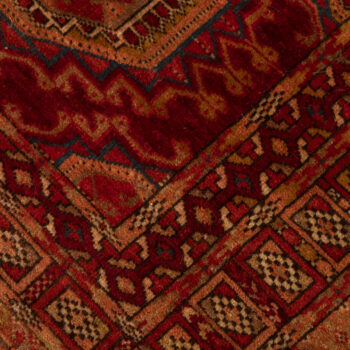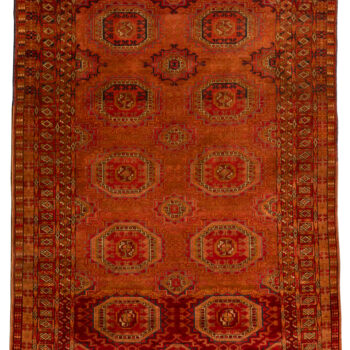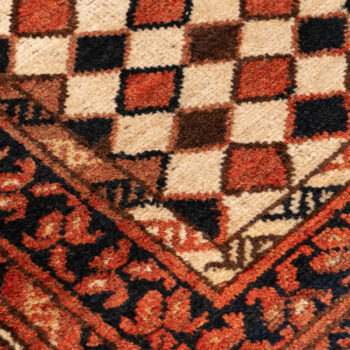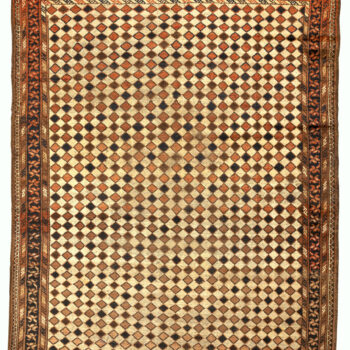Turkmen
Turkmen carpets are made by different peoples who inhabit Central Asia or the area known as Western Turkestan, a region located east of the Caspian Sea and which today is made up of five countries: Turkmenistan, Kazakhstan, Kyrgyzstan, Uzbekistan and Tajikistan. Carpets are made throughout the area, but mainly in Turkmenistan by the Ersari, Salor, Saryk, Tekke and Yomund ethnic groups of Turkmen who live beyond Turkmenistan in northern Iran and Afghanistan. Carpets made in East Turkestan, which is located in the western region of China and borders some countries in West Turkestan, are also considered Turkmen.
The dominant color of Turkmen carpets is an infinite composition of red tones. Rugs are made from wool, cotton and silk. Today, the main ornamental elements of Turkmen carpets are national symbols and decorate many architectural buildings in Ashgabat, the capital of Turkmenistan.

Carpets from the Beshyr, Tekke, Chodor, Yomud, Ersary and Salor groups tell the story of the regions where they were made, about nature and inhabitants, totems and ancient symbols. Each gul of the Turkmen carpet is related to local ethnic characteristics and is a complex image that embodies the mythology about the creation of the universe and man and their relationship with the outside world.
The Turkmen call the main designs on their carpets gul (“flower”) and the small ornaments gülcha (“small flower”)

Northern Afghanistan is inhabited by the Ersari and Saryk Turkmen groups. The design of their carpets consists of large octagons (guls) on a reddish-brown field arranged in three to five rows along with arabesques in the shape of diamonds, polygons or small stars. In the center of the octagons or on their sides, stylized plants are generally drawn (clover or cherry blossom, for example) and appear in alternating colors in the octagons. Each diagonally opposite pair has the same base color – orange – yellow, light red, dark blue and white. The border includes small diamonds, rectangles or other geometric shapes arranged with some complementary design. A common feature is the inner border with intertwined flowers. Having the dominant red field, the dark blue and brown outlines and the contrasting colors of the ornaments, produce a striking color in these rugs. The Afghan rugs that are today mass-produced in northern Iran and Afghanistan in the blood-red color of chemical origin share only the design with the rare ancient Afghan wares of nomads available today.
Tekke
Antique rug details include designs in golden yellow, orange, ruby red (often woven into red silk), as well as light blue and green and with contrasting colors and outlines of designs in dark blue and brown tones. Today, Tekke rugs of different colors and light shades are rare. A simple, very uniform and dark bluish-red color prevails in current pieces. Recently, Tekke rugs of all sizes have appeared on the market. But these reproductions are not made by the Tekke Turkmen.
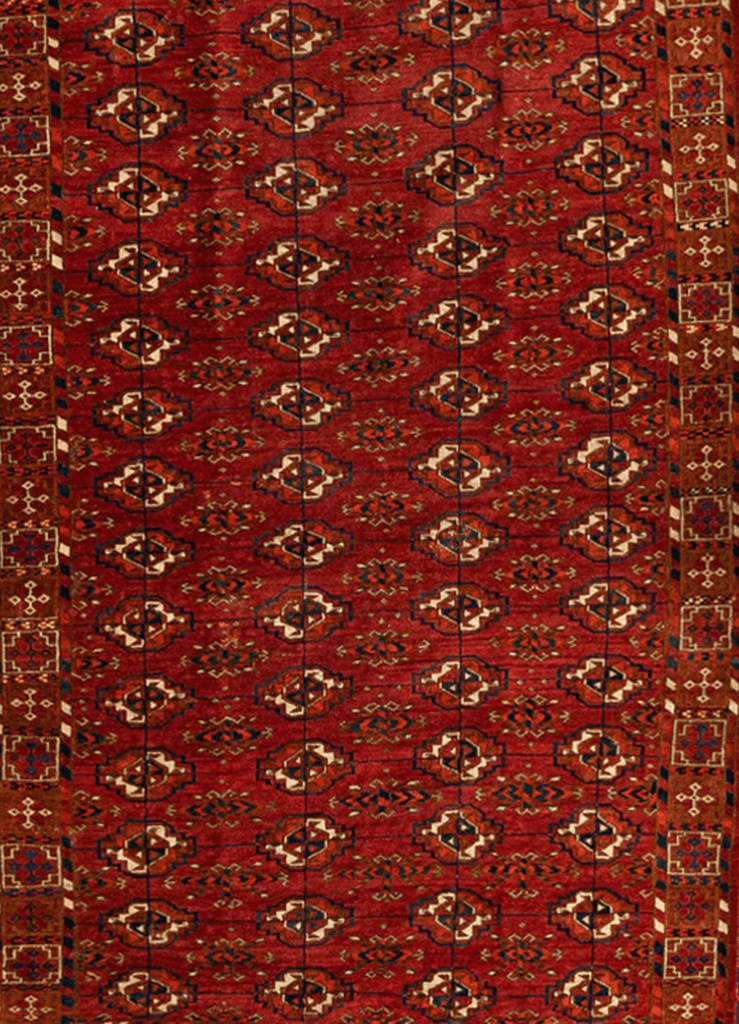
On the edge there is a row of octagons and flowers separated by leaves and vines alternating with palm trees, octagons or other designs. The coloring is very diverse. The field and border are usually copper or violet red, but can also be done with earthy red or rust red.
Antique rug details include designs in golden yellow, orange, ruby red (often on red silk), as well as light blue and green and contrasting colors and outlines of dark blue and brown. Today, Tekke rugs of different colors and light shades are rare. A simple, rather uniform and dark bluish-red color prevails. Recently, Tekke rugs of all sizes have appeared on the market. But they are not made by the Turkmen Tekke people.
Both the structure and the pile of old Tekke rugs are made of wool. Cotton also began to be used for the weft in later pieces. Sometimes silk or cotton highlights design elements. The rug is made with an asymmetrical knot.
Ersari
Ersari carpets are produced by the Ersari Turkmen who inhabit northern Afghanistan and southern Turkmenistan. Part of the Ersari population settled in the cities of Beshir and Bukhara.
The oldest Ersari rugs can be identified by their own designs. They are the only Turkmen to compose the medallion design. They also adopted traditional Persian and Caucasian designs that include botéh, herati, lattice and minakhani. Additionally, the Ersari produced large quantities of large-format and gallery carpets, which was unusual among other Turkmen groups.
Ersari rugs are geometric or have a floral style. The design is made up of the gul (flowers). The guls are repeated horizontally and vertically across the field and are woven into larger and smaller shapes in alternating rows. The borders are generally narrow and feature leaves and vines alternating with guls and other nomadic designs.
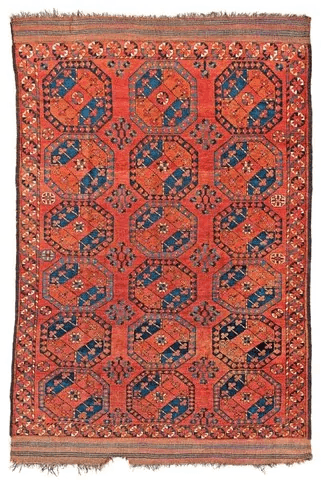
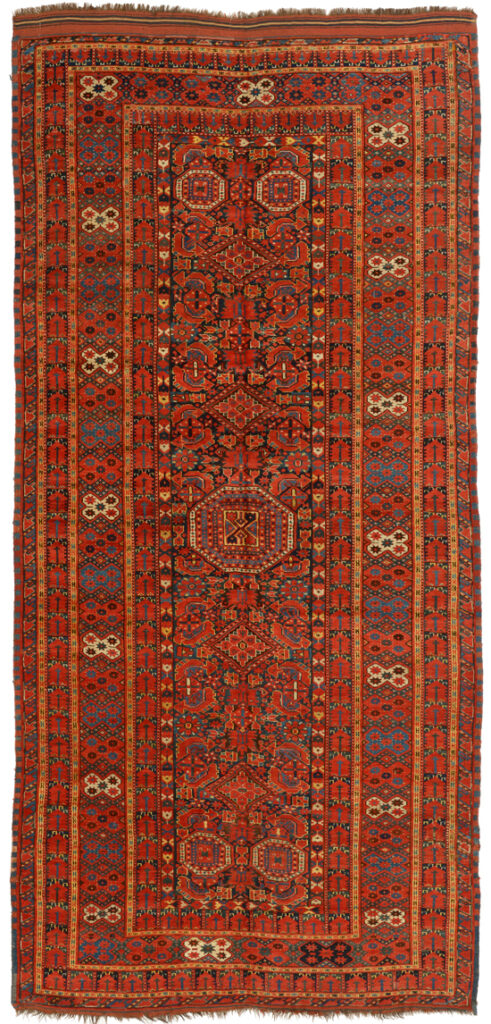
Beshir
Beshir carpets have the richest and most diverse ornamentation of all Turkmen carpets. They come from the Amur-Daria region, a former emirate of Bokhara. Beshir carpets are made by the Ersari Turkmen. Ancient Beshirs display a continuous and repeating design consisting of herati motifs with palm trees, flowers and leaves. They usually have a central octagonal medallion with an octagon in each corner and are known as Herati Beshirs. The border ornamentation is made up of stylized flowers with different geometric compositions. The dominant color is earthy red. Sometimes the same color as the central area of the carpet is the main color used in the ornaments densely spread on a dark blue field and highlighted by yellow outlines.
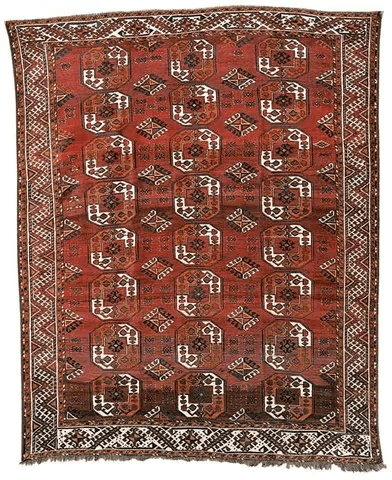
Kizil-Ayak rugs have a red color on the main field. Dark blue, orange, beige and white are used in the design details and dark brown is used in the outlines.
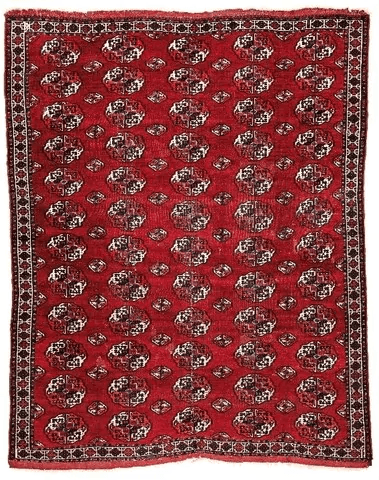
Salor
The Salor live in the eastern and southern regions of Turkmenistan, along the banks of the Murghab River. Salor carpets belong to the best and most beautiful Turkmen works of art. They are considered high-level art not only in the carpet market, but in art in general. Few pieces are known, around 37 have been registered, most of them in private collections and museums. Antique Salor carpets, produced during the 16th-19th centuries, are considered classic carpets of the Turkmen groups, because of the quality of the weave, dyeing and design and have become a reference for all other Turkmen groups.
Generally, Salor rugs feature octagonal geometric shapes surrounded by arabesques or double hooks. The same motifs also appear inside the octagon itself, facing the center. These designs are arranged in a staggered board shape with three to five rows of smaller octagons or diamond-shaped flowers.
The color used is generally a dark red-violet with orange, white and dark blue motifs. The edges are often made up of numerous bands, always filled with rhombuses. The structure and pile of the rug are made from the best quality wool. Sometimes silk or cotton are partially woven to highlight the geometric figures. The asymmetrical knot is always used.
Saryk
The Saryk inhabit southern Turkmenistan and northern Afghanistan. They live among other Turkmen groups, such as the Ersari, Salor and Tekke, who have influenced their carpet weaving designs.
Saryk rugs are geometric in style, decorated with octagons that can have geometric elements on both sides (known as wings). Generally, in the center there is a hexagon with a cross formed by four flowers. The center of the carpet is divided into three or four checkered rows with small octagons. The borders are generally narrow and rich in ornaments.
The dominant color is red-violet in the central field and earthy red in the details, with dark blue, white and brown as contrasting colors. The Saryks of Afghanistan often feature the Ersari gul, or polygons arranged in rows with small hook-shaped arabesques. The decoration, coloring and structure of the edges have the characteristics of Afghan carpets.
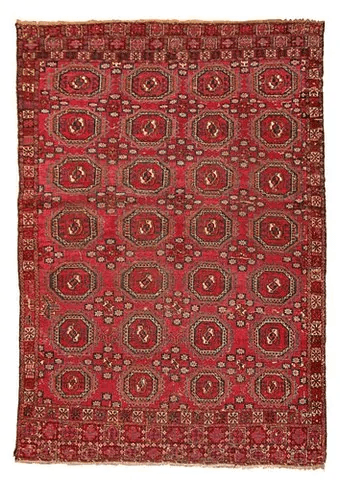
The structure and pile of Saryk rugs were made with wool. However, goat hair can also have wisdom used in the warps. Cotton is rarely used for weft. Sometimes silk or cotton are partially woven into the design elements. The symmetrical knot is normally used, but the asymmetrical knot was used in older pieces. Early Saryk rugs are considered a form of art in the antique rug market. All over the world, museums and collectors continue to acquire these beautiful pieces of art.

There are types with simple octagons with smooth faces and others in which the octagons alternate with other decorative motifs. Most often, the cream-colored border is decorated with spiral leaves and flowers. Borders with different ornamentation are often added to the ends. A reddish-brown or dark violet field dominates the few shades of this coloration.
Chodor
The Chodor are a Turkmen group living in the northern region of Turkmenistan and around Khiva, on the border with Uzbekistan.
Chodor rugs are very reminiscent of Yomud rugs in technique, style and color. The geometric figures of ancient Chodor carpets consist of a diamond-shaped division of the field in which motifs called ertman-gul are aligned. The main motif is a diamond with paired hook extensions and various designs within it, which alternate in rows with smaller diamonds. The newer pieces have diamonds with hooks on the sides with stylized flowers. The main and adjacent borders are generally similar to Yomud rugs.
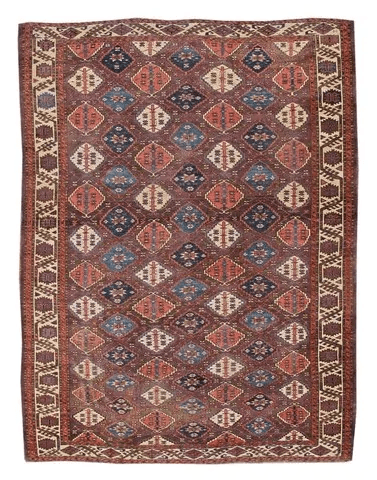

Figalli Oriental Rugs
We do not sell rugs. We bring rare works of art to your home in the form of rugs.
Our services
You are Protected
Copyright © 2023 Figalli Oriental Rugs, All rights reserved. Desenvolvido por Agência DLB – Agência de Marketing Digital em Porto Alegre



